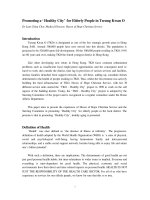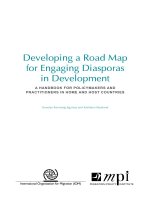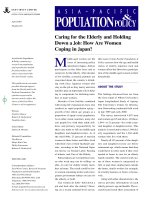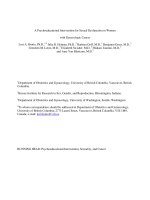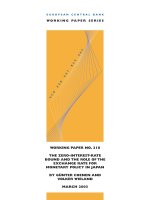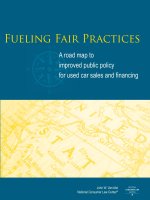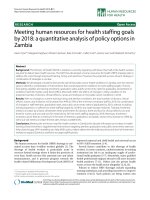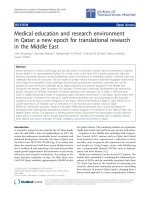Developing a Road Map for Engaging Diasporas in Development potx
Bạn đang xem bản rút gọn của tài liệu. Xem và tải ngay bản đầy đủ của tài liệu tại đây (219.03 KB, 11 trang )
Developing a Road Map
for Engaging Diasporas
in Development
A HANDBOOK FOR POLICYMAKERS AND
PRACTITIONERS IN HOME AND HOST COUNTRIES
Dovelyn Rannveig Agunias and Kathleen Newland
Developing a Road Map for Engaging Diasporas in Development
A Handbook for Policymakers and Praconers in Home and Host Countries
CHAPTER 10: CAPITAL MARKET INVESTMENTS
205
Chapter 10: Capital Market Investments
Financial ows from migrants and their descendants are at the
heart of the relaonship between migraon and development. Policy
aenon has focused on the largest and most visible of these ows
migrants’ remiances and, to a lesser but growing extent, the direct
investments that diaspora entrepreneurs make in businesses in their
countries of origin. The third major category of private nancial resources
that originate from diasporas, capital market investments, are much less
understood and examined. Capital markets are absolutely fundamental
to development, as they are the instuons that mobilize savings for
investment, providing the long-term funds that power wealth creaon
(and, in nancial crises, wealth destrucon). They include markets for
stocks (equies), bonds, loans, asset-backed securies (as in commodity
markets), and a complex array of instruments derived from one or more
of these (derivaves). Collecvely, this kind of investment is known as
indirect, or porolio, investment.
Diaspora members have substanal nancial assets beyond their
current income, including savings and rerement accounts, real property,
and investments in stocks, bonds, and other nancial instruments.
394
Governments, banks, and businesses in countries of origin have a strong
interest in creang nancial instruments that can aract these diaspora
savings into investments that contribute to sustainable development.
Diaspora investors tend to have dierent percepons of risk than
non-diaspora investors. Given their homeland connecons, diaspora
members may have beer informaon about investment opportunies
in their countries of origin and are less sensive to exchange-rate risks
than other investors, because they have domesc-currency obligaons in
their country of origin such as support payments to family members or
running costs of domesc businesses, mortgages, or returns to domesc
share-holders. They also may have a dierent me horizon. While most
investors in emerging markets have a fairly short meframe for prot
expectaons, many diaspora investors are willing to capture return on
their investments over a longer period. They may even be willing to accept
lower returns than they might otherwise secure, as a ‘patrioc discount,”
on investments in the homeland.
Developing a Road Map for Engaging Diasporas in Development
A Handbook for Policymakers and Praconers in Home and Host Countries
CHAPTER 10: CAPITAL MARKET INVESTMENTS
206
It should be noted, however, that it is dicult, if not impossible,
given available data, to idenfy mainstream capital market parcipaon
by diasporas. Investments made by diaspora members in convenonal
investment vehicles open to all investors are indisnguishable from other
foreign investments. But governments and businesses in some countries
of origin have created nancial instruments especially designed to tap into
the wealth of diaspora populaons. While some are aimed at high-net-
worth individuals, some are accessible to small-scale savers. Policymakers
have not yet tapped the potenal of devising reliable and investor-friendly
mechanisms and instruments that allow migrants (and other small-scale
savers) to invest in capital markets without undue exposure to risk.
1 Policy and Program Options
There are a variety of vehicles that governments use to mobilize
diaspora wealth via capital markets. These include:
ÂÂ Special deposit accounts denominated in local and foreign
currencies;
ÂÂ Transnaonal loans that allow diasporas to purchase real estate
and housing in their countries of origin;
ÂÂ Diaspora bonds allowing governments to borrow long-term funds
from diasporas;
ÂÂ The securizaon of future remiance ows that allow banks
to leverage remiance receipts for greater borrowing at lower
interest rates.
This secon discusses three of the above instruments, namely
special deposit accounts, diaspora bonds, and transnaonal loans.
Securizaon of remiance ows is discussed in Chapter 6.
A. Creating a Special Category of Deposit Accounts
A number of countries, such as Bangladesh, India, and Tunisia, have
introduced a special category of deposit accounts at commercial banks
in countries of origin, where members of the diaspora can deposit their
savings. Holders of such special accounts are given preferenal interest
rates as well as the opon of having accounts denominated in a foreign
currency. In some cases, interest from such accounts is fully or partly tax
exempt. Economists Chrisan Dustmann and Josep Mestres esmate
Developing a Road Map for Engaging Diasporas in Development
A Handbook for Policymakers and Praconers in Home and Host Countries
CHAPTER 10: CAPITAL MARKET INVESTMENTS
207
that between 1992 and 1994, approximately 48 percent of immigrant
households in Germany maintained savings in their countries of origin.
395
Allowing diaspora members to set up savings accounts in their
countries of origin not only allows banks to expand bank capitalizaon for
lending and onward investment, but also oers diasporas the opportunity
to parcipate in capital markets in their countries of origin. (In many
countries, holding a bank account in a country is oen a prerequisite for
invesng in capital markets.)
Bank accounts that are denominated in foreign currencies can oer
some advantages to diasporas. First, in oering such foreign-currency
denominated bank accounts, banks are the ones that shoulder the risk of
foreign exchange. If account holders hold currency in local denominaon,
they are the ones who bear foreign currency risks. Foreign currency
deposit (FCD) accounts have oen been used by domesc savers to
maintain the real value of their savings during mes of macroeconomic
instability. Some banks may also oer two types of FCD accounts: current
and xed-term deposit accounts. Current deposit accounts allow account
holders to withdraw funds whenever they choose, while xed-term
deposit accounts, in return for higher rates, impose some me restricons
on when account holders can withdraw their principal without paying a
penalty.
In recent years, a number of developing and emerging economies
— including Albania, Ethiopia, India, Kenya, Nigeria, Sri Lanka, and Turkey
— have liberalized their banking regulaons to aract diaspora savers to
FCD accounts.
396
Naonal Bank of Ethiopia. In 2004 the Naonal Bank of Ethiopia
created FCD accounts specically targeng members of the Ethiopian
diaspora to invest domescally. Naonal Bank of Ethiopia Direcve
No. FXD/31/2006 created a foreign currency account that nonresident
Ethiopians and nonresident foreign naonals of Ethiopian origin (and
their respecve businesses) could open. These accounts are denominated
in three currencies — the US dollar, Brish pound, or euro — but banks
can also accept deposits in other converble currencies, including the
Canadian dollar, Saudi riyal, Japanese yen, Australian dollar, and United
Arab Emirates (UAE) dirham.
397
Those residing abroad can open accounts
either in person or by post. The minimum amount required to open an FCD
account is $5,000 or its equivalent in any of the accepted currencies, and
the maximum deposit amount is $50,000. Among other things, holders of
FCD accounts can use them as collateral or a guarantee for loans or bids
Developing a Road Map for Engaging Diasporas in Development
A Handbook for Policymakers and Praconers in Home and Host Countries
CHAPTER 10: CAPITAL MARKET INVESTMENTS
208
and to make local payments in Birr. According to the direcve, interest
is not paid to nonresident foreign currency current accounts, but banks
have the freedom to set their own interest rates for nonresident foreign
currency xed accounts.
Central Bank of the Republic of Turkey. The Central Bank of the
Republic of Turkey also oers foreign-currency-denominated xed-term
deposit accounts and “Super FX” accounts for Turkish passport holders
residing abroad. FCD xed-term accounts can be denominated in euros,
US dollars, Brish pounds, or Swiss francs; require a minimum deposit of
the equivalent of $1,000 for at least two years; and pay an annual interest
rate of 0.25 percent for all currencies. Super FX accounts are available in
euros and US dollars; require a minimum deposit of €5,000; must be held
for one, two, or three years; and earn annual interest rates of 1 percent
for accounts denominated in euros and 0.25 percent for those held in US
dollars.
398
Eligible individuals can open accounts at the bank’s branches
in Turkey and at partner banks in the Netherlands, the United Kingdom,
Germany, France, and the United States.
India’s NRI Deposit Accounts. Nonresident Indians (NRIs) have
the opon of holding their savings in foreign currency or in rupee-
denominated accounts in India. As of March 2010, NRIs held an esmated
$14.3 million in foreign-currency-denominated accounts and $33.6 million
in rupee-denominated accounts.
399
The Foreign Currency (Non-Resident)
Account (Banks) scheme can be denominated in Brish pounds, US dollars,
Japanese yen, euros, Canadian dollars, and Australian dollars. The accounts
are available for xed terms of not less than one year and not more than
ve years. The accounts can also be used to obtain loans in India and
abroad, both in domesc and foreign currencies. Loans made in India to
the account holder must be used for personal purposes or for carrying out
business acvies; direct investment in India on a nonrepatriaon basis by
way of contribuon to the capital of Indian companies; and acquision of
real estate in India for personal residenal use. However, loans cannot be
used for on-lending, for carrying out agricultural or plantaon acvies,
or for investment in real estate businesses.
B. Offering Diaspora Bonds
In recent years, governments have been increasingly using their
consular networks to sell diaspora bonds, designed to tap into diaspora
assets. The issuance of diaspora bonds is a form of innovave nancing
that can help developing countries support infrastructure projects.
Issuers of diaspora bonds gain access to xed-term funding, oen at
Developing a Road Map for Engaging Diasporas in Development
A Handbook for Policymakers and Praconers in Home and Host Countries
CHAPTER 10: CAPITAL MARKET INVESTMENTS
209
discounted interest rates due to a “patrioc discount,” or the dierence
between the market interest rate for government debt and the interest
rate that diasporas are willing to accept given their aachment to their
country. However, Israel, India, and other countries learned that this
“patrioc discount” is oen small in reality and somemes does not
materialize. The larger advantage of issuing diaspora bonds is that they
can mobilize relavely small amount of funds from the diaspora into
substanal resources for development.
400
Importantly, the default risk
normally associated with internaonal sovereign-debt holdings may be
reduced for diasporas. Diasporas view the country’s ability to pay interest
and principal in local currency as relavely strong and thus nd diaspora
bonds aracve.
A number of governments have issued bonds to raise capital among
their diasporas. Israel has issued diaspora bonds annually since 1951
through the Development Corporaon to raise long-term infrastructure
investment capital. Egypt reportedly issued bonds to Egypan workers in
the Middle East in the late 1970s. India issued diaspora bonds in 1991,
1998, and 2000 to avoid balance-of-payments crises and to shore up
internaonal condence in India’s nancial system during mes of nancial
sancons or special needs. Sri Lanka has oered Sri Lanka Development
Bonds since 2001 to a number of investor categories including nonresident
Sri Lankans, while Ghana oered Golden Jubilee savings bonds in 2007.
Finally, Ethiopia issued the Millennium Corporate Bond in 2008 to raise
capital for the state-owned Ethiopian Electric Power Corporaon (EEPCO)
in an eort to expand its distribuon grid.
401
A number of other governments, including a rather desperate
Greek government, have tried to raise money through the issuance of
diaspora bonds. In March 2011 Greece announced that it was looking
to raise $3 billion in a series of quarterly sales, primarily from wealthy
members of its diaspora populaon, and began bond sales to investors
in the United States. Credit rang agencies, including Moody’s, have
downgraded Greece, giving it a junk rang. Though members of the Greek
diaspora, which numbers 11 million, may have emoonal aachment to
their homeland, more is required to draw substanve investment. The
government needs to market its bonds with care and wisdom, encing
members of the diaspora with long-term visions of development and
economic growth.
Further, the World Bank is advising a number of countries, such as
Kenya, Nigeria, and the Philippines, on the issuance of diaspora bonds.
Despite improvements in credit rangs among a number of developing
Developing a Road Map for Engaging Diasporas in Development
A Handbook for Policymakers and Praconers in Home and Host Countries
CHAPTER 10: CAPITAL MARKET INVESTMENTS
210
and emerging economies, governments must sll face the challenge of
convincing members of their diaspora to purchase government bonds. It
is parcularly dicult to get individuals who have ed countries due to
oppressive governments to invest in their countries of origin. Ethiopia,
for example, has failed to raise enough money through its issuance of
diaspora bonds.
402
Golden Jubilee Savings Bonds. In 2007 the Ghanaian government
issued $50 million worth of ve-year “Golden Jubilee” savings bonds,
available for purchase at approved nancial instuons unl June 2008,
to both Ghanaians living in Ghana and abroad. Its objecve was to raise
money for infrastructural development projects in all ten regions of
the country, raise awareness of the importance of saving, and diversify
nancial instruments on oer to the market. Holders of the accrual
bonds do not receive the xed 15 to 15.5 percent interest, compounded
semiannually, unl redempon.
403
Unfortunately, according to Strategic
African Securies Limited (SAS), the lead advisors of the bond, Ghana’s
eorts, such as Ethiopia’s in 2008, failed to produce substanve results
as it managed to raise only 20 million of the expected 50 million Ghana
cedis.
404
State of Israel Bonds. State of Israel bonds are securies issued by
the Israeli government through the Development Corporaon of Israel
that are marketed to the Israeli diaspora in parcular to help build the
naon’s infrastructure. Sixty years aer David Ben-Gurion established
the program in 1951, State of Israel bonds have raised over $33 billion.
405
Today, Israel considers the issuance of these bonds as a stable source of
overseas borrowing and an important mechanism for maintaining es
with its diaspora. Investors have a number of opons including mulple
maturity and minimum subscripon opons that sell for as low as $100
and as high as $100,000. With capital inow generated through the
issuance of these bonds, the government has spent over $26 billion for
transportaon, energy, telecommunicaons, water resources, and other
essenal infrastructure projects.
406
Grand Ethiopian Renaissance Dam Bond. In 2011 Ethiopia
launched its second diaspora bond, the Renaissance Dam Bond, to fund
the construcon of the Great Renaissance Dam, designed to be Africa’s
largest hydroelectric power plant. The issuance of its second diaspora
bond, which looks to raise $4.8 billion, follows on its inial eort to raise
money for EEPCO through its Millennium Corporate Bond. However,
the rst bond did not reach its nancial targets due to risk percepons
among investors with respect to EEPCO, the government, and the polical
Developing a Road Map for Engaging Diasporas in Development
A Handbook for Policymakers and Praconers in Home and Host Countries
CHAPTER 10: CAPITAL MARKET INVESTMENTS
211
environment in Ethiopia. The Renaissance Dam Bond is available in
minimum denominaons of $50 and transferrable to up to three people.
Buyers are given the opon of purchasing bonds with a ve-year or a ve-
to-ten-year maturity as well as choosing between bonds with or without
interest. Bonds issued in the local birr currency are available in ve-year
and over-ve-year maturies. Five-year bonds have a 5.5 percent yield
while over-ve-year bonds yield 6 percent interest.
407
Moreover, the
government is covering any remiance fees associated with the purchase
of these bonds. The bonds are available in foreign currencies as well as in
the local birr. The Commercial Bank of Ethiopia (through its branches), the
Ethiopian embassies and consulates, and other representave oces are
responsible for selling the bonds in foreign currencies. It remains to be
seen how the diaspora bond fares, but this does not change the fact that it
is an innovave mechanism for diverng investment toward public social
service and infrastructure projects.
408
C. Offering Transnational Loans to Diasporas and their Families
Members of the diaspora residing abroad are able to apply for and
obtain small transnaonal loans in their countries of origin from banks or
micronance lenders. Financial instuons issue transnaonal loans for
business expansion, home improvement, home purchase, and educaon
expenses, but have found mortgage lending to be most successful. By
obtaining transnaonal loans, migrants living abroad are able to provide
credit to family members back home. In general, migrants cannot use
assets that they possess abroad as collateral for transnaonal loans due
to dierences in bankruptcy laws and enforcement between countries.
Pag-IBIG Overseas Program. Several public and private enes oer
transnaonal loans for a variety of purposes. The Philippine government’s
Pag-IBIG Overseas Program, for example, allows overseas Filipino workers
to access short-term loans under the Mul-Purpose Loan Program (to
help nance members’ immediate medical, educaonal, or livelihood
needs; minor home improvements including the purchase of furniture and
appliances; and other related needs) and the Calamity Loan Program (for
those in need of nancing due a recent calamity). In addion, overseas
Filipino workers can also access a housing loan under the End-User
Financing Program or the Magaang Pabahay, Disenteng Buhay Program.
To be eligible for a housing loan, overseas Filipino workers must be a
member of the Pag-IBIG and have made remiance contribuons to the
Pag-IBIG Fund for at least 24 months at the me of the loan applicaon.
409
Developing a Road Map for Engaging Diasporas in Development
A Handbook for Policymakers and Praconers in Home and Host Countries
CHAPTER 10: CAPITAL MARKET INVESTMENTS
212
Micronance Internaonal Corporaon (MFIC). Since 2006
MFIC, a US-based nancial services corporaon, has partnered with
micronance lenders and remiance transacon operators in El Salvador,
Guatemala, and the Plurinaonal State of Bolivia to provide transnaonal
mortgage loans to immigrants in the United States and Spain. MFIC links
remiances to housing micronance. Partnering with two micronance
instuons (MFIs) — Apoyo Integral de S.V. and Sociedad Cooperava de
Ahorro y Crédito (AMC) — MFIC launched a pilot program in El Salvador
in September 2006. Under the program, the MFIs and MFIC shared
50 percent of all risk and revenues for each transnaonal loan made
to unbanked Salvadorans living in the Washington, DC metropolitan
region for the purpose of home and land purchases, construcon or
home improvement, investment in exisng businesses, or educaonal
expenses. MFIC conducted loan interviews and credit analyses, veried
and processed loans, and administered and collected loan payments.
MFIs, on the other hand, appraised properes, evaluated business plans
and any co-borrowers, dealt with loan documentaon, and disbursed the
loan. In general, loans ranged from $8,000 to $40,000, had terms of 10
to 15 years, used property or business assets in El Salvador as collateral,
and charged interest rates of between 12 to 16 percent. The program
brokered seven transnaonal loans with an outstanding loan porolio of
$132,000, but received 118 applicaons —29 of which were denied and
82 of which were ineligible.
410
In 2010 MFIC secured a strategic partnership with Fedecredito, the
largest federaon of credit associaons and workers’ banks in El Salvador,
to establish a transnaonal mortgage loan program that would allow
Salvadorans residing in the United States to nance purchase of a house
in El Salvador.
411
Under the program, clients could apply and repay the
mortgage loan at Alante Financial, an MFIC-owned nancial instuon
targeng immigrants in the United States.
2 Challenges and Lessons Learned
A number of nancial instruments, including special deposit
accounts, diaspora bonds, securizaon of future remiances, and
transnaonal loans, can help countries tap into the wealth of the diaspora.
Such approaches enable governments to not only rely on migrants’
current income but also on their savings and to focus more on long-term
investments and capitalizaon of their markets. With the right mix of
instruments and appropriate markeng, countries can potenally aract
Developing a Road Map for Engaging Diasporas in Development
A Handbook for Policymakers and Praconers in Home and Host Countries
CHAPTER 10: CAPITAL MARKET INVESTMENTS
213
more investment, which fosters the growth of domesc capital markets,
raises sovereign creditworthiness, and creates a virtuous cycle leading to
sustainable development. However, governments face a number of key
challenges in promong such instruments and making investment work
for their naonal development.
A. Help Improve Transparency and Increase Faith in Local
Financial Institutions and Businesses
Special category deposit accounts, diaspora bonds, the securizaon
of future remiances, and transnaonal loans are among the nancial
instruments whose potenal have yet to be fully exploited. Mullateral
instuons as well as public and private instuons can help developing
countries improve their banking sector and raise credit rangs. One of the
fundamental challenges for many countries that lack foreign investment
is the percepon of economic, polical, or social risk among the diaspora
and general investors. While members of the diaspora may have a desire
to contribute to development in their countries of origin given their home
bias, inherent polical risks can hinder their contribuons. Therefore,
there is a need to address fundamental governance issues in parallel with
encouraging investment in countries of diaspora origin.
B. Increase Knowledge and Expertise about Financing Vehicles
Targeting the Diaspora
While debt instruments such as diaspora bonds can have a posive
impact on a country’s development (as Israel has experienced, for example),
the majority of policymakers and diaspora communies have limited
awareness about this nancial instrument.
412
Moreover, governments are
oen deterred by complex regulatory requirements for issuing diaspora
bonds abroad. For example, if a country wishes to issue diaspora bonds in
the US retail market, it must register its product with the US Securies and
Exchange Commission (SEC), whose disclosure requirements are relavely
rigorous. In addion, governments must pay a relavely high fee to issue
a diaspora bond in certain markets. In the United States, for example, fees
can exceed $500,000. Governments should therefore strategically select
countries whose regulatory requirements are less stringent than the
United States, whose issuance fees are lower, and where large diaspora
populaons are present.
413
Developing a Road Map for Engaging Diasporas in Development
A Handbook for Policymakers and Praconers in Home and Host Countries
CHAPTER 10: CAPITAL MARKET INVESTMENTS
214
C. Promote International Agreements on Regulation and
Enforcement
The divergence of naonal bankruptcy laws can hinder the
implementaon of transnaonal loan programs and other nancing
vehicles. Governments should strengthen internaonal cooperaon to
facilitate the transnaonal mobilizaon of assets, for instance, by agreeing
on mutual enforcement of bankruptcy laws (which would enable banks to
accept assets held abroad as collateral for lending) and harmonizing and
sharing credit scores.
414
D. Move Away from Stopgap Measures and Toward Long-Term
Capitalization of Markets
If governments maintain atudes and policies that favor short-
term gain over sustainable long-term growth, they are unlikely to aract
diasporas to invest in their countries. For example, when issuing diaspora
bonds, governments cannot solely rely on “patrioc discounts” to raise
sucient capital to fuel development. Rather, they must assure and
convince potenal diaspora investors that their investments will produce
posive returns and outcomes over the long term. Other possible opons
to aract investors would be to oer tax advantages for purchasers of
diaspora bonds.
415
E. Overcome Legal and Technical Issues in Issuing Financing
Instruments
While transnaonal loan schemes can help migrant families
purchase homes or start businesses in their countries of origin, there are
a number of challenges that must be addressed. For example, MFIC found
that the 50-50 percent risk-sharing arrangement between MFIC and MFIs
was dicult to implement. It also found that if a client were to default on
his/her loan, MFIC could take no legal acon in the United States. Dierent
instuons underwring the policy also produced varying assessments
on the level of credit risk of loan clients. Many clients also lacked key
informaon on the valuaon of property or businesses. Further, MFIC also
faced other legal quesons such as whether or not it was appropriate to
oer a loan to an undocumented immigrant who otherwise qualied for
one.
416
